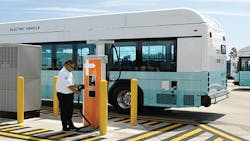Transit is the ultimate equalizer. It gives people dignity and access to opportunities. When my family came to the United States, transit enabled my parents to provide for us. I remember taking the bus for $0.75 to my first job at McDonald’s. I’ve come a long way since then but transit helped me get here. Based on my experience working with customers to plan and deploy hundreds of chargers for transit agencies across North America, here are answers to three common questions about how to get the most out of electrification for your agency.
What key criteria should transit agencies prioritize when evaluating electrification solutions?
It may seem obvious, but one of the most important criteria is selecting an experienced partner that has a proven, successful history with your bus OEM. Surprisingly, a charging vendor’s experience and staffing levels are often overlooked. If a transit agency expects to deploy hundreds of buses and chargers in the depot and on route, it must select a partner with experience installing charging at scale. Strong service level agreements (SLAs) are also vital. Few charging companies have experience with multiple large-scale deployments and a full team of transit electrification experts. Choose one that does.
Transit is a lifeline for communities. If a bus is down, people can’t get to work, the grocery store or doctor’s appointments. Choose a vendor with the experience and staff to ensure your community members can get where they need to go. Don’t be a guinea pig — put these criteria high on your list.
How can agencies help employees adjust to sustainable transportation?
Maintenance workers and drivers see the biggest impact from switching to electric; their experience is overwhelmingly positive. We’re seeing maintenance workers trade in their wrenches for multimeters and computers. Not everyone is excited about the transition initially, but soon you can’t tear them away from electric vehicles (EVs) and their colleagues can’t wait to go electric too. Quality of life improves when going from breathing diesel fumes to working in a clean environment, and when stations are made with field-replaceable units, turnaround time for repairs is a lot quicker too.
Drivers also appreciate the quiet, responsive operation of e-buses. It can take time to adjust but they have a better work experience and improve on-time route performance. Being able to merge into traffic more quickly thanks to the instant acceleration of electric buses can save significant time. These seconds add up, reducing stress about staying on schedule.
Where have you seen agencies struggle when transitioning to zero-emission buses?
A common problem is issuing separate RFPs for EV charging hardware, charge management software, telematics, yard management and other systems, without considering their interoperability. Every company will indicate that its software is interoperable, but achieving seamless integration between these components is complex. You don’t want to struggle with your electrification project because your charging stations, software and telematics data aren’t synchronized. EVs run routes differently based on driver behavior or route characteristics, potentially getting 20 percent more or less range. Without integrated telematics, you’re just guessing about what’s going on. And you can’t provide on-time service based on a guess.
While agencies may want to procure from multiple vendors to diversify their approach and reduce risk, it can be less risky to deal with one partner instead. With an integrated solution, agencies can count on a suite of products designed to work together and one clear contact to resolve problems. Choosing an integrated solution can increase your likelihood of success.
We also see agencies getting distracted by technologies that are not ready for the market. For example, vehicle-to-grid technology may prove useful in a few years, but today, managed charging — scheduling charging for off-peak times and sharing power across stations — remains the most proven approach to success. Implementing managed charging now will give agencies a foundation in electrification to lean on when other technologies are ready.
Finally, early and active communication with your utility is critical. DC fast charging is an amazing tool to keep transit buses charged and ready. That said, the technology is complex and site make-ready is a major component; agencies should be prepared for that. It’s never too soon to start planning. Let us help you start or continue a successful electrification journey: get in touch at chargepoint.solutions/masstransit.
--------------
Valery Kang is director of E-Bus, North America at ChargePoint.

